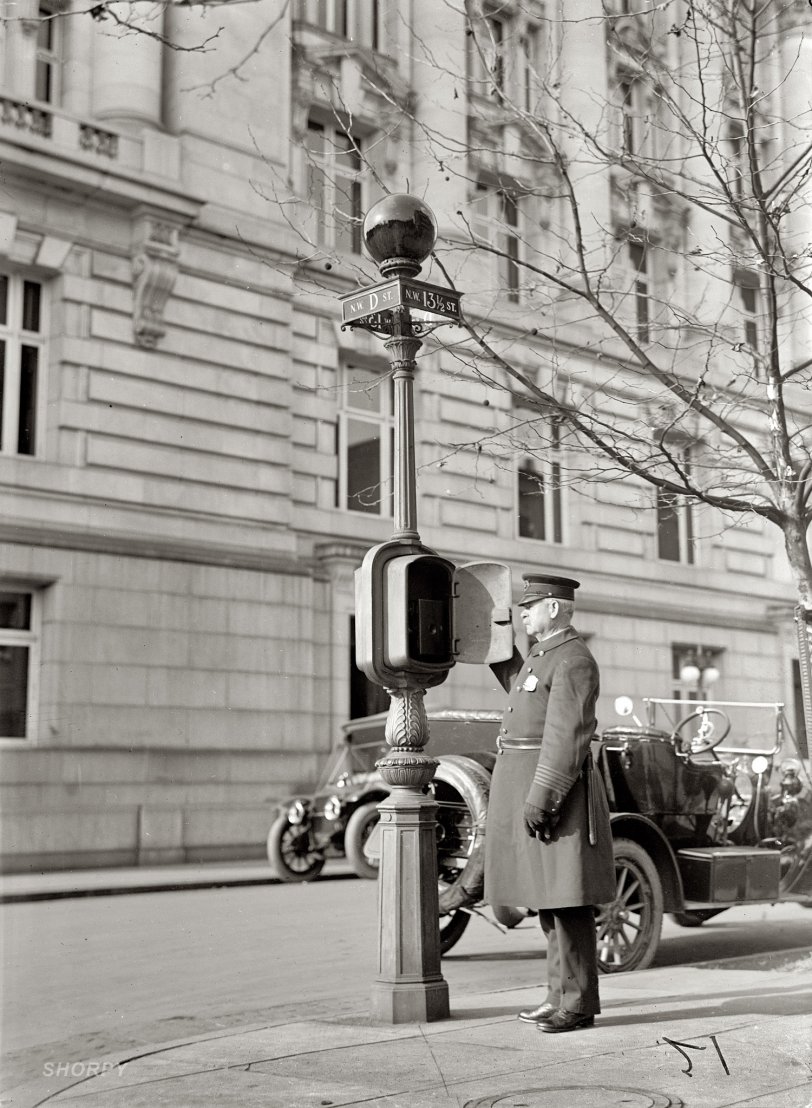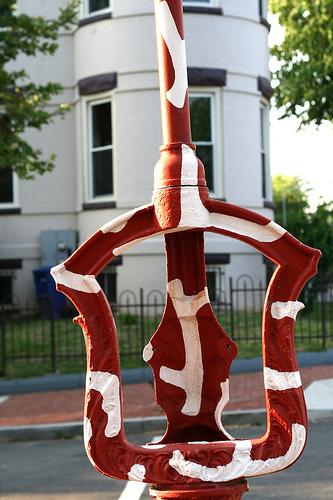


Framed or unframed, desk size to sofa size, printed by us in Arizona and Alabama since 2007. Explore now.
Shorpy is funded by you. Patreon contributors get an ad-free experience.
Learn more.

- Roll your own
- Rugged and real!
- A Charles Purcell - Mama Cass Connection
- Uncle SAAM
- Obfuscation
- One Chocolate Soldier rode away
- Victor Marquis de la Roche
- The Little House Across Way ...
- Vanderbilt Gates
- Vanderbilt Mansion
- You can still see that gate
- Withering heights for me
- So Jim,
- Top Heavy
- Re: Can't Place It.
- Bus ID
- Since you mention it
- The White Pages ?
- Moonlight Tower
- 1907?
- Fire(men) and Water
- Can't Place It
- Can anyone
- Wings
- Where's Claudette and Clark?
- Overbuilt Rolodex
- One song
- Give Me Wings Please!
- PRR
- Pinball Wizards
Printporium
Police Call Box: 1912

Washington, D.C., circa 1912. "Police Call Box." Finally we have a closeup of a mysterious item of street furniture on view in many of our urban scenes -- what looks like a streetlight with a dark globe. These were telephones with a direct line to the police station. When a call went out, the red illuminated globe showed arriving officers where help was needed. This one was downtown at 13½ and D streets N.W. Harris & Ewing Collection glass negative. View full size.
Fire Boxes
Call boxes are the cop ones. They were faded blue / gray, needed a call box key to use and had a phone handset where the cop would call in every hour or whatever. If they didn't check or call in, other cops would come looking for them. Remember, no radios in those days, so you were by yourself, fire & police. The fire boxes in DC were painted red (with red light so the public could see them from a distance) with the pedestal being painted gray. They were Gamewell boxes that tapped out unique 2, 3 or 4 numbers several times via telegraph wire to 300 McMillan Dr NW to our Fire Communications Division. Each box had its own unique number and the first number told you what section or area in DC the box was located. The rest of the number identified the exact location.
The kids were "hooking" the boxes so often, DCFD switched to "phone" call boxes in the late 1970s that the public could call in on. Many kids called all the time or just let the phone hang, so CD quit answering the calls. That obviously couldn't last, so with pay phones being everywhere, the boxes were removed. 911 calls were free. So every pay phone was used as a fire "street box." The "boxes" were removed, but the pedestals with harp are still in most parts of the city and some were made into works of art. In DC, police & fire boxes were never attached to each other! Different pedestals for each.
Call Boxes
The last time I used a callbox was 1987 in New York. Only a few Dinosaurs knew about where they were, and we had callbox keys. The son-of-a-gun callbox phones worked perfectly in 1987. Technology and vandalism were the problems. Those caught damaging or defacing a callbox usually left their teeth and some blood at the site. I still remember the locksmith shop that had the keys. New owners, they speak some other language, have no clue what a callbox was. Maybe I should take a ride and see if they have those keys hanging around; A memento. Original issue key was returned in late 1987 when they were officially retired. Radios of today go to Central communications/911 center; Callboxes went to the stationhouse and were answered by the Desk Officer. Nothing ever got logged in or recorded, and was typically and usually the topic of disagreements and arguments, especially after hours, in a local pub.
Call Boxes Police & Fire
I was a DC officer starting in 1968 and I still have my call box key, it is mounted next to my badges on a plaque. I never saw one with a red light on it. The fire boxes were removed first since they were open to the public and were being pulled daily by kids and driving the fire department crazy.
Milwaukee call boxes
According to one of the last alderman newsletters I received while still a resident of Milwaukee, the call boxes will be removed as they are found to be unrepairable. Full-scale removal will cost too much money, so they still have a lease on life -- for now.
Red Light
Perhaps things were a bit different in D.C., but my research shows the red light did not tell officers "where help was needed," but rather the light was to have officers call in to find out where to respond to a call.
In small towns, there was often a red light at the main intersection. If it was lit, the officer on patrol went to the closest telephone he could find to call in and ascertain the nature of the call.
[The D.C. call box lamps seem to have been on all the time, according to various newspaper articles. Nighttime at least. - Dave]
Call box key
I'm still carrying mine, just in case. Be prepared.
Still working in '77
When I was appointed a police officer in D.C. in 1975 we were issued a large brass call box key, which was also used to open the cell doors on some of the lockups in the precincts. The phones were still active in 1977 when I had to pull one after my portable radio quit working while on foot patrol. That was the only time ever I used a call box; it was on the corner of Jackson Place and Pennsylvania Avenue NW.
Gator Boxes
The University of Florida campus has these all over the place; in fact I believe they are so frequent that you can usually make visual contact with at least one other call box when you are standing at one.
No Doctor here yet, though.
Funky call box art
Flickr member Mississippi Snopes noticed the repurposing of this call box on S Street NW:

Call Boxes Cont'd
Milwaukee still has a working call box system. It's a simple touch-tone phone nowadays. There used to be a fire alarm on the opposite side until they were removed in the late 70's or early 80's to cut down on false alarms. In the age of cell phones, I don't know how much longer the call box system will last.
Comedy fodder
Like so many now-unfamiliar appurtenances of bygone days, police call boxes were once so commonplace that everybody would understand jokes surrounding them, like Laurel & Hardy using one to store their lunch in their 1933 comedy short The Midnight Patrol.

Who?
The British version appears from nowhere, making funny noises, and brings you not just any doctor, but The Doctor.
Reporting in
Call boxes were the standard communication for foot patrol officers. Each policeman carried a key to open the box and was required to report into the precinct station hourly. The obvious drawback was there was no way to get messages out to the foot patrol in case of emergency. In 1959, the department began experiments with portable "walkie-talkies" to improve communication with foot patrols. The D.C. call box system was discontinued in 1976. More info and pictures here.

1969 Jack E. Boucher photograph of call box in Georgetown, Historic American Buildings Survey
Call Box
I have one in my yard minus the mast and light. It made its way to California with some others several years ago.
Still around
A similar version of these is still around. At the University of Maryland College Park campus are the "blue light" call boxes. You can call anywhere on campus actually, plus campus police and 911. At the top of every pole is a nice blue light a la Kmart.
Art on Call
These call boxes are all over the place in D.C. Not the pole with the globe, but the frame that held the box itself. They are being turned into street art.
Educational
Very educational entry. I wonder if any of these still exist?
























On Shorpy:
Today’s Top 5